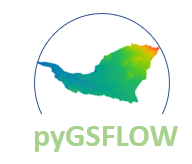pyGSFLOW is a python package to create, run, and post-process GSFLOW-based models
Project description

pygsflow
pyGSFLOW is a python package to Create, Read, Write, Edit, and Visualize GSFLOW models
GSFLOW model development has previously been a piecemeal approach that required multiple software tools to build, edit, postprocess, and visualize models. pyGSFLOW changes this by being a tightly coupled scripting library that provides support for GSFLOW, PRMS, and MODFLOW. Custom modules for both GSFLOW and PRMS are included in this library. MODFLOW support is provided by wrapping the Flopy package (Bakker and others, 2021) with GSFLOW specific code. Together, these three pieces create a single integrated scripting package that helps to standardize and streamline model development and calibration.
This is the development repository for pyGSFLOW. Official USGS releases can be found here
API Documentation
pyGSFLOW API documentation can be found @
https://pygsflow.github.io/pygsflowdocs/
Examples
Basic examples can be found in the Tutorial Examples tab of the pyGSFLOW API documentation at https://pygsflow.github.io/pygsflowdocs/tutorials.html#
Interactive jupyter notebook example problems can be found in the examples directory.
https://github.com/pygsflow/pygsflow/tree/master/examples
Requirements
Version 1.1.0 (Master branch and from pypi)
- Windows or Linux operating system (GSFLOW is not currently compiled for MacOS)
- Python 3.6 or greater
- FloPy 3.3.4 or greater, note for Python 3.6 use (
pip install flopy==3.3.4) - NetCdf4 (optional, required for netcdf exporting and autotesting) (
pip install netcdf4) - Numba (optional, but recommended for raster resampling routines) (
pip install numba)
Version 1.1.1 (Develop branch)
- Windows or Linux operating system (GSFLOW is not currently compiled for MacOS)
- Python 3.6 or greater
- Flopy 3.3.4 or greater (
pip install flopy) note for Python 3.6 use (pip install flopy==3.3.4) - NetCdf4 (optional, required for netcdf exporting and autotesting) (
pip install netcdf4) - Numba (optional, but recommended for raster resampling routines) (
pip install numba)
Installation
Version 1.1.0 (Master branch and from pypi)
The pygsflow repository can be installed using pip. To install the release version, open a terminal, command prompt, or anaconda prompt and type:
pip install pygsflow
Version 1.1.1 (Develop version with most recent updates)
To install the development version, open a terminal, command prompt or anaconda promt and type:
pip install https://github.com/pygsflow/pygsflow/zipball/develop
Alternatively the user can download a copy of the repository, open a command prompt or anaconda promt terminal, cd into the trunk directory and type:
pip install .
Additional Linux installation instructions
To use the default version of GSFLOW for Linux that is distributed with pyGSFLOW the user needs to set the permissions of the GSFLOW binary program to execute. From a terminal window cd into the trunk/bin directory of the pyGSFLOW repository and write:
chmod u+x gsflow
chmod u+x mfnwt
chmod u+x CRT_1.3.1
In some cases symbolic links to gfortran-10 must be set up this can be done with
sudo ln -fs /usr/bin/gfortran-10 /usr/bin/gfortran
sudo ln -fs /usr/bin/gcc-10 /usr/bin/gcc
sudo ln -fs /usr/bin/g++-10 /usr/bin/g++
Authors
Ayman Alzraiee, Joshua Larsen, Donald Martin, Rich Niswonger
How to Cite
IPDS number
IP-128405
Contributing
Please see Contributing.md
Running Autotests Locally
pyGSFLOW uses github actions CI to automatically test code for each commit and pull request. These tests can also be run locally. To run tests locally, navigate to pygsflow's root directory, open a command prompt, anaconda prompt, or terminal window:
with nosetests:
cd autotest
nosetests -v
with pytest:
cd autotest
pytest
How to find pygsflow's root directory:
Open a python terminal and type:
import gsflow
print(gsflow.__file__)
Project History
This project is a refinement and continuation of the original pygsflow repository at:
https://github.com/aymanalz/pygsflow
Disclaimer
This software is preliminary or provisional and is subject to revision. It is being provided to meet the need for timely best science. The software has not received final approval by the U.S. Geological Survey (USGS). No warranty, expressed or implied, is made by the USGS or the U.S. Government as to the functionality of the software and related material nor shall the fact of release constitute any such warranty. The software is provided on the condition that neither the USGS nor the U.S. Government shall be held liable for any damages resulting from the authorized or unauthorized use of the software
Project details
Download files
Download the file for your platform. If you're not sure which to choose, learn more about installing packages.















